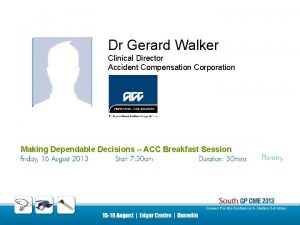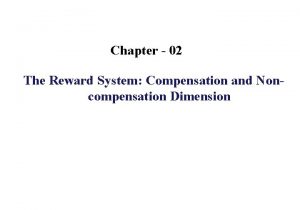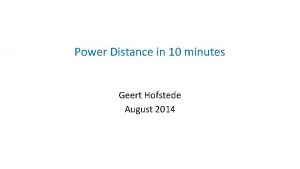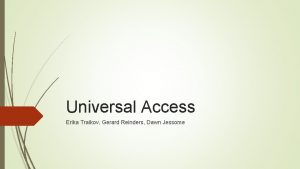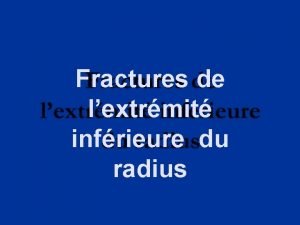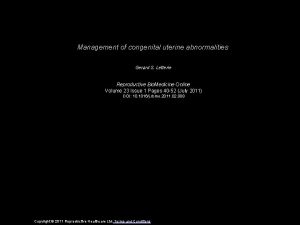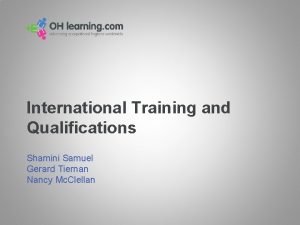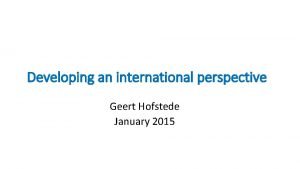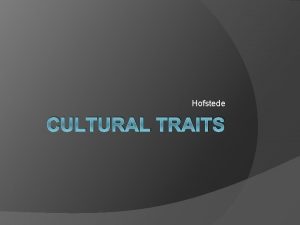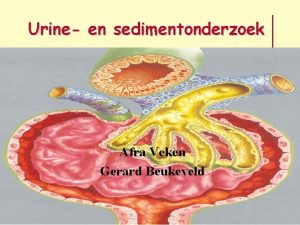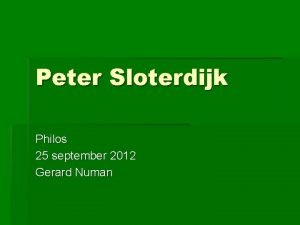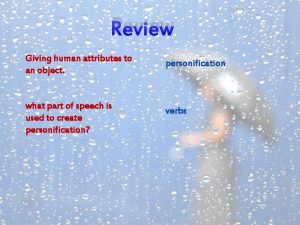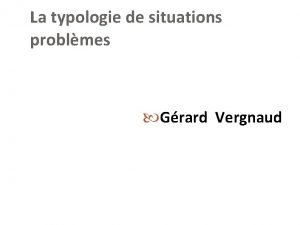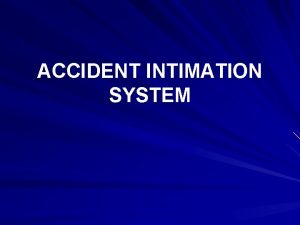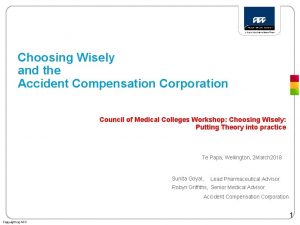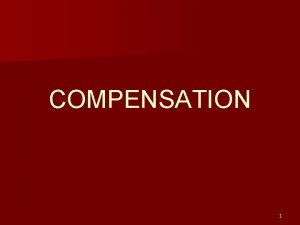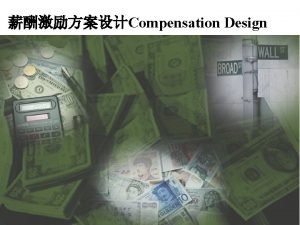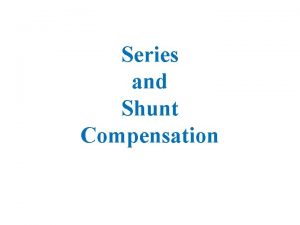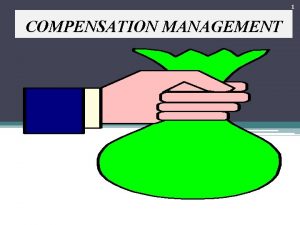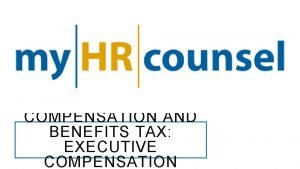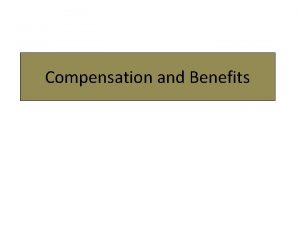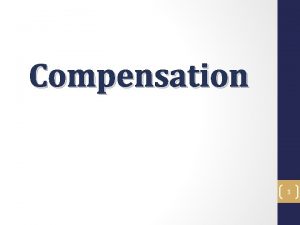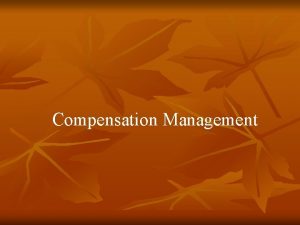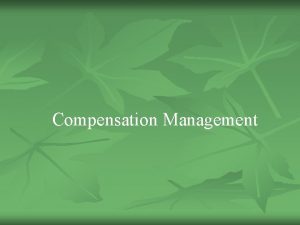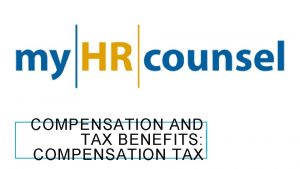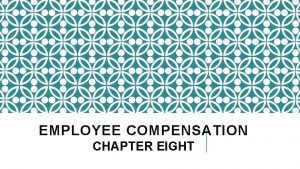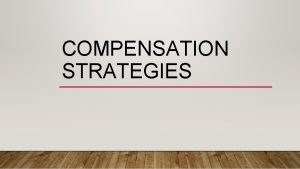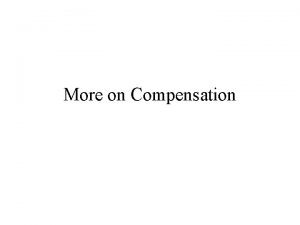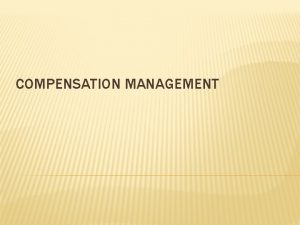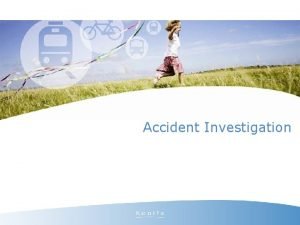Dr Gerard Walker Clinical Director Accident Compensation Corporation

































- Slides: 33

Dr Gerard Walker Clinical Director Accident Compensation Corporation Making Dependable Decisions – ACC Breakfast Session

Making Dependable Decisions South GP CME 2013 Dr Gerard Walker This version: 06. 08. 2013

This morning • ACC – overview • Gradual process claims • Certification to support employment & rehabilitation

ACC Scheme • ACC is a 24 hour ‘no fault scheme’ and, in turn, those with accepted claims give up the right to sue • All NZ citizens and residents are eligible for cover if ordinarily resident in NZ at the time of accident • Visitors to NZ are eligible for cover if the injury occurred in NZ

ACC – what is covered • Personal injuries caused by accident • Work-related gradual process injuries, diseases • • & infections Sensitive (sexual abuse claims) Injuries that occur as a result of medical treatment

Work Related Gradual Process Claims (WRGPDI) Schedule 2 – Onus is on ACC to disprove work causation and. . . The three-part test (s. 30) – Onus is on claimant to prove work causation

WRGPDI: The 3 -part test (Section 30) 1) Person has been exposed to something at work believed to be causative (or partly causative); and. . 2) If the causative factor also occurs in the person’s non-work environment then it is a requirement that the non-work exposure was not independently capable of causing the condition … 3) The work task or work environment must also place the client at significantly greater risk of developing that injury NB – pre-existing atopy does not exclude cover

WRGPDI: The 3 -part test (Section 30) – some exclusions 1. Conditions caused “wholly or substantially” by the aging process 2. Causative exposures outside NZ (except if person “ordinarily resident”, i. e. working for NZ company operating overseas and earnings declared in NZ or away from NZ when exposed but only intended to be absent from New Zealand for no longer than 6 months) 3. Conditions caused by exposures before 1 April 1974 (unless the deemed date of injury was after that date & earlier legislation also satisfied; generally meaning that the causative employment needed to have continued past 1 April 1974)

• What would make you think that your patient has an occupational disease or gradually acquired work injury?

WRGPDI: What is an occupational disease? In order to make a diagnosis of an occupational disease all of the following points need to be satisfied: 1. Their disease should plausibly have an occupational cause 2. Occupational exposure must be sufficient to cause disease 3. Time of exposure must be appropriate relative to timing and 4. nature of the onset, development, and any resolution of disease in question Other diseases need to be reasonably excluded Reference: Hunter’s Diseases of Occupations, 9 th Edition, Baxter et al (Ed), Arnold, 2000

What are commonly arising occupational disease/gradual onset injuries & in what settings do they arise?

WRGPDI: conditions often claimed • CTS: repeated forceful gripping or wrist movements or • • • sustained wrist postures Tenosynovitis: must have the condition Tennis elbow: repeated forceful arm movements Rotator cuff conditions: WRGPDI: work with arms elevated (flexion/abduction shoulders beyond 60 degrees) Cubital tunnel syndrome: highly repetitive elbow flexion/extension, seldom caused by work Osteoarthritis: little evidence re causative role for work

WRGPDI: conditions not claimed enough? • • Dermatitis - wet work Bladder cancer – various chemicals Lung cancer and asbestos exposure Sinonasal & nasophayrnx – wood dust, chromium Leukemia - benzene WRGPDI: COPD – organic dust Adult onset asthma -– organic dust, various chemicals

What is an occupational disease? – issues for GPs 1 1. 2. 3. 4. 5. 6. What is the diagnosis? Does the client have an Injury? Is there a recognisable causal agent in the workplace? Has the work caused (or contributed to the cause) of the condition? Cause versus aggravation Harm of false attribution

Certifying Fitness for Work Certification – an opportunity and a challenge • We have been over-sold benefits of time off work • Now a growing appreciation of the positive effects of work on health and the harm associated with worklessness • We need a culture change, from prescribing time off work to prescribing time at work • Certification provides an opportunity and a challenge The clinical role is to assess fitness for work and prescribe a safe level of activity

Certifying Fitness for Work and health: the evidence • Work is generally good for health and well-being 1 • Unemployment: strongly association with poor health 2 • Work and re-employment: the positive effects of return to work have been seen in various populations and settings 2, 3 • Families without a working member are more likely to suffer persistent low income, poverty and tangible health effects 4 1. Marmot M. Status Syndrome, Bloomsbury, London: 2004 2. Waddell G, Burton K. Is work good for your health and well-being? TSO, London: 2006 3. Rueda S et al. Am J Pub Health Vol 102, No. 3, 2012 4. Burgess, S. , Propper, C. and Rigg, J. (2004 ) Households Below Average Income (HBAI) A 9 /95 -200/06

• Why does work improve health?

Certifying Fitness for Work Why does work generally improve health? Work provides people with a number of benefits: • • provides useful physical activity adds meaning to life gives a sense of community provides social supports provides structure to days, weeks, holiday breaks economic hardship is avoided minimises risky behaviours (like alcohol and drugs) 1. White P. Ed. Oxford University Press 2005. 2. Waddell G, Burton K. TSO, London: 2006.

Certifying Fitness for Work What may delay a patient getting back to full participation in work ?

Certifying Fitness for Work Delays in return to work affect us all • Employees are disadvantaged • Employers’ perspectives • Economic loss • YET high % of NZ doctors routinely certify fully unfit. For example, in 2011: – >20, 000 certs/year fully unfit for 30 days – >10, 000 exceeded+ expect. recovery times

Certifying Fitness for Work Facing the challenge TRADITIONAL PARADIGM BETTER PARADIGM Work is risky when you have an injury – so stay away Work is generally good for health SO stay at work with safe accommodation

Certifying Fitness for Work A framework to guide effective conversations Clinical assessment - wholistic Work – travel, tasks, environment

• What sort of problems do you encounter when writing medical certificates?

Certifying Fitness for Work Common certification problems • Doctor – patient relationship • Diagnostic uncertainty • Difficult judgements about fitness for work • Patient advocacy • Insufficient time • Insufficient information about work tasks & work envt • Confidentiality issues – can communicate re work fitness & prognosis with employer, e. ACC 18 form for employer

Certifying Fitness for Work Other common certification problems • Lack of occupational health expertise • Nonmedical flags as barriers to rehab • Communication with the Case Manager • Too much focus on the injury and biomedical factors when certifying • Pressure from patients • “There’s no light duties, Doctor”

Certifying Fitness for Work The GP is part of a team Supervisor Surgeon SAW Coordinator Patient Case Manager GP Physio

Certifying Fitness for Work Systems in place to support your work certifying ACC has developed some new approaches to help you and your patient: • Return to Work (RTW) Assistance – use the tick box on the e. ACC 18 • Stay at Work (SAW) service • Clinical Review of Fitness for Work (CRFW)

Certifying Fitness for Work ACC resources and services to support you The new e. ACC 18 allows emphasis on fitness • New box: “Is return to work assistance required? ” • Allows you to request SAW or new clinical review of fitness for work

Certifying Fitness for Work Anna • • Sprained her right ankle badly five days ago X-rayed three days ago – has come back clear Seen physio Ankle strapped Weight-bearing tentatively Using crutches intermittently Elevates her ankle when sitting Taking paracetamol regularly

Certifying Fitness for Work Anna (continued) • Examination reveals minimal swelling • Appears comfortable • You prescribe anti-inflammatories You are having a busy day. As Anna is going out, she says she thinks she should have another week off work and asks whether you would do another medical certificate for her. How do you respond?

Certifying Fitness for Work Anna (continued) How do you respond? • Provide a certificate for one more week off work • Provide a certificate for two days off work and then review • Provide a certificate for a full clearance for work • Provide a certificate with defined restrictions and safe activities

Certifying Fitness for Work Summary • • • Certification provides both an opportunity and challenge Work, in general, is good for health Certified absence can lead to disability and health problems Conversations with your patients make all the difference Understand the clinical implications of the “flags” ACC has resources and services your patient could benefit from as they recover from injury • Take ownership of this shift in your practice It’s a clinical task – you are the right person to prescribe safe levels of activity

Thank you
 Dr gerard walker
Dr gerard walker Compensation and non compensation dimensions
Compensation and non compensation dimensions Power distance hofstede
Power distance hofstede Gerard reinders
Gerard reinders Fracture pouteau colles
Fracture pouteau colles Gerard rademakers
Gerard rademakers Gerard van rijn
Gerard van rijn Gerard bossard
Gerard bossard Gerard genette narratologia
Gerard genette narratologia Keith goodman
Keith goodman Inscape and instress
Inscape and instress Cupid and psyche francois gerard
Cupid and psyche francois gerard Gerard grard
Gerard grard Racine carrée - villemin gerard
Racine carrée - villemin gerard Dr gerard olive
Dr gerard olive Gerard piqu
Gerard piqu Gm hopkins
Gm hopkins Gerard letterie
Gerard letterie Gerard willering
Gerard willering Gerard tiernan
Gerard tiernan Gerard schuster
Gerard schuster Geert hofstede 1980
Geert hofstede 1980 Gerard hendrik hofstede
Gerard hendrik hofstede Gerard polla
Gerard polla Gerard villemin
Gerard villemin Dysmorfe erytrocyten nierinsufficiëntie
Dysmorfe erytrocyten nierinsufficiëntie Iosh
Iosh Gerard van drielen
Gerard van drielen Los 2hisnd com resource
Los 2hisnd com resource Gerard joling henna tattoo
Gerard joling henna tattoo Gerard grard canada
Gerard grard canada Gerard numan
Gerard numan Mr brown the circus clown rhyme scheme
Mr brown the circus clown rhyme scheme Typologie vergnaud
Typologie vergnaud
